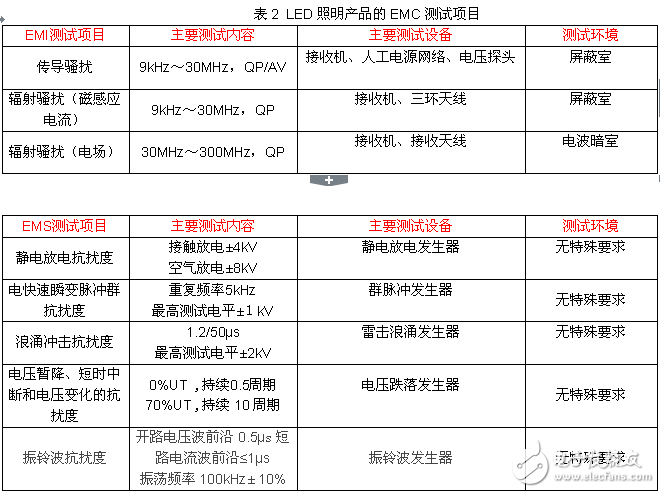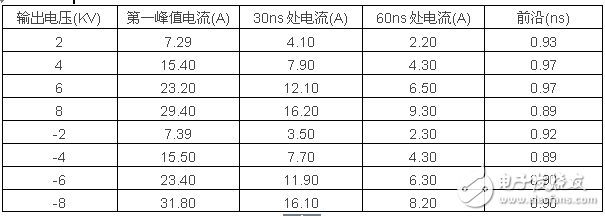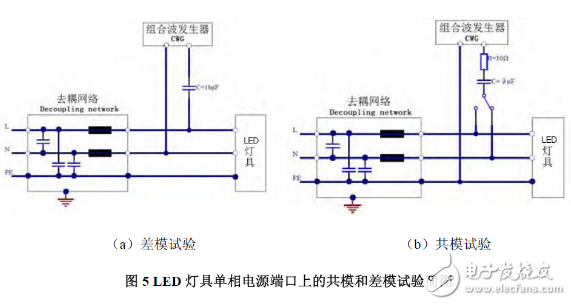Electromagnetic compatibility (EMC) problems and detection techniques for lighting products
With its remarkable advantages such as high luminous efficiency, long life, energy saving and environmental protection, LED has gradually established its leading position in the lighting industry, such as indoor and outdoor lighting. Along with the introduction of various national support policies, a large number of LED lighting products manufacturers have emerged in China, but the quality of LED lighting products is uneven, which has affected the promotion of LED lighting products to a certain extent. According to the special inspection of the market quality inspection, the failure rate of LED lighting products reached 73.9%, among which the unqualified items were mainly concentrated on electromagnetic compatibility test items such as harmonic current, surge impact and disturbance voltage. Electromagnetic compatibility (EMC) is an important factor affecting the reliability of LED lighting products.
1, EMC test standards
At present, there is no EMC standard for LED lighting products in the world. The current practice is based on the field of application of LED lighting products, and reference is made to implement relevant standards. For automotive LED lighting products, refer to CISPR25 "Limitations and Measurement Methods for Protection of Radio Disturbance Characteristics of Vehicle Receivers", ISO 7637-2 "Transient Conduction of Electrical Vehicles Caused by Conduction and Coupling of Road Vehicles along Power Lines" EMC tests are carried out in accordance with ISO11452 “Test methods for electromagnetic interference components emitted by narrow-band emitted electromagnetic energy for road vehiclesâ€. This part of the paper does not discuss this article. The focus of this paper is on the EMC test standards for general-purpose LED lighting products (except for automotive lighting, aerospace lighting, photocopying machines, etc.), as shown in Table 1.

2, EMC test project
EMC test items for LED lighting products can now be classified into electromagnetic interference (EMI) and electromagnetic sensitivity (EMS). EMI (Electromagne TIc Interference) is an electromagnetic disturbance test that tests LED lighting products that may cause degradation or damage to other things, including equipment, systems, people, animals and plants. EMS (ElectromagneTIc SuscepTIbility) is an electromagnetic sensitivity (anti-interference) test that tests the immunity of LED lighting products to electromagnetic disturbances such as lightning strikes, ESD static shock tests, and ringing waves.

Table 2 lists the EMC test items for LED lighting products, including the main test content, main test equipment, and test environment. The following will focus on the three aspects of EMI electromagnetic interference, electrostatic discharge, and surge impact.
2.1, EMI test
Electromagnetic interference EMI (ElectromagneTIc Interference), there are two types of conducted interference and radiation interference. Conducted interference refers to the coupling (interference) of signals on one electrical network to another electrical network through a conductive medium. Radiated interference refers to an interference source that couples (interferes) its signal to another electrical network through space. In high-speed PCB and system design, high-frequency signal lines, integrated circuit pins, various types of connectors, etc. may become radiation interference sources with antenna characteristics, which can emit electromagnetic waves and affect other systems or other subsystems in the system. normal work. As we all know, EMC's testing target is electrical and electronic equipment, and lighting equipment as an important part of it, naturally there are corresponding constraints. For example, the FCC certification in the United States and the CE certification in the European Union have proposed related test items for LED lighting equipment. When talking about electromagnetic interference, there are generally two sources of interference; one is conducted interference, mainly because the interference signals generated by electronic devices interfere with each other through conductive media or public power lines, and FCC certified conducted interference scanning of LED lamps The test frequency starts from 0.15MHz to 30MHz, and the conducted interference scan test frequency in CE certification starts from 9KHz to 30MHz. Another type of interference is radiation interference, which mainly means that the interference signal generated by the electronic device transmits the interference signal to another electric network or electronic device through spatial coupling. The FCC certification space radiation interference scanning test frequency of the LED lamp starts from 30MHz to 1GHz. At the end, the space radiation interference scanning test frequency in CE certification starts from 30KHz to the end of 300MHz.
In the lighting industry, there are two methods for testing EMI in the 9KHz-30MHz band. One is Antenna (antenna) and EMI receiver, which are based on CISPR15, EN55015, GB17743. For low-frequency magnetic field devices that may be generated by lighting fixtures, the three-loop antenna specified in CISPR16-1-4 is required to measure the low-frequency magnetic field radiated disturbance. It is mainly tested by a three-ring antenna and an EMI receiver, and the test is carried out in a shielded room. Note: The three-loop antenna converts the low-frequency magnetic field components in the X direction, Y direction and Z direction into RF signals, and transmits them to the EMI receiver through the coaxial switch three channels for measurement; the other is to use the LISN test method, which is required for testing. It is performed by EMI receiver + artificial power network + LISN and test software. The conducted disturbance test system is used to measure the disturbance generated by the power port of the lamp and the luminaire under normal working conditions. The LISN realizes the isolation, sampling, impedance matching of the RF signal, and provides the electrical path for the EUT, and the EMI receiver measures the RF signal. And finally analyzed, processed and judged by the EMI test software. The test should be carried out in a shielded room.
At the same time, the CDN method is used in the EMI test in the 9KHz-300MHz band. Another method of testing the radiated electric field disturbance of the lighting device is provided in the CISPR 15, EN55015 and GB17743 standards, namely the CDN common mode terminal voltage method. Adopt CDN method, mainly including EMI receiver, CDN and attenuator. The test can be carried out in a shielded room.
According to relevant basic standards such as CISPR16, we have developed and produced two EMI test equipments. For the traditional and new lighting industry standards, the scanning frequency of the two devices is different. The EMI-9KB EMI scanning frequency is 9KHz~300MHz, suitable for LED and Detection of traditional lighting equipment; EMI-9KA EMI scanning frequency is 9KHz~30MHz, which is mainly suitable for the detection of traditional lighting equipment. To determine whether the measured object meets the standard, we quote three values ​​of peak value, quasi-peak value and average value. Considering the difference between different standards, the software can directly call GB17743, FCC, EN55015, GB4343 and other judgment standards.
2.2, electrostatic discharge
LED is a semiconductor device. In the stages of LED manufacturing, assembly, transportation, storage and use, production equipment, materials, and operators may bring static loss to the LED, resulting in premature LED leakage current increase and light attenuation. Even the "dead light" phenomenon. The electro-optic discharge of the LED includes a reverse leakage current, a forward IV characteristic, and a luminous flux, which cause a certain degree of deterioration. Electrostatic discharge is one of the important factors affecting the reliability of LED and LED lighting products.
LED is a key material for LED lighting products. For the electrostatic discharge immunity test of LED, it should comply with relevant international standards such as American National Standard ANSI/ESD STM5.1, ANSI/ESD STM5.2, International Electrotechnical Association Standard JESD22-A114D, JESD22-A115-A, US Army Party standard MIL-STD-883 and so on. The ESD61000-2 electrostatic discharge generator developed by Shanghai Lixin Electronic Technology is specially designed for the determination requirements and characteristics of LED electrostatic sensitivity. It adopts machine mode (MM) and human body mode (HBM) electrostatic discharge test, and the electrostatic discharge voltage can reach up to 30KV; LED voltage and current measurement accuracy can reach 0.2%; LED forward voltage resolution is 1mV; reverse leakage current resolution is 0.01μA. For LED lighting products, the overall electrostatic discharge immunity test shall be carried out in accordance with GB/T 17626.2/IEC61000-4-2. Contact discharge is the preferred test method for 20 consecutive discharges of each accessible metal part (excluding the terminals) on the LED lighting product case, positive and negative for 10 times each. Air discharge can be used at locations where contact discharge is not possible. Indirect discharge shall be applied to the horizontal or vertical coupling plate in accordance with the provisions of GB/T17626.2. In order to ensure the repeatability and consistency of the test results, the electrostatic discharge test must be arranged in accordance with the content of Section 7 of GB/T17626.2. The calibration data of ESD61000-2 electrostatic discharge generator is as follows:
Calibration data:

2.3, surge impact
Lightning strikes are a common climatic phenomenon. According to statistics, there are more than 40,000 thunderstorm centers around the world, with 8 million lightning strikes per day, which means that about 100 lightning strikes per second occur. Lightning strikes nearby ground or adjacent objects, creating a powerful electromagnetic field around it that induces high voltages and large currents. On the other hand, surges in power systems are also a very common phenomenon. Such as main power system switching, short circuit and arcing faults between equipment grounding grid or grounding system.
LED lighting products, especially outdoor lighting products, will seriously affect product reliability if they do not pay attention to the protection of lightning surges. It is not uncommon for large-area LED street lights to be damaged after thunderstorms; according to a quality inspection conducted by a quality supervision bureau for LED street lights, nearly 60% of LED street lights cannot meet the lightning surge requirements. In order to evaluate the surge immunity performance of LED lighting products, surge impact testing shall be carried out in accordance with the requirements of IEC/EN61000-4-5 and GB/T 17625.5. The test principle is shown in Figure 5. The coupling network of common mode and differential mode test is different. The differential mode test is the line-line test. The coupling capacitance is 18μF, which is used to simulate the capacitance between the actual cloud layer and the earth. The test is a line-ground test. The coupling network consists of a capacitor and a resistor connected in series, with a capacitance of 9 μF and a resistance of 10 Ω.

The SG61000-5 intelligent lightning surge generator developed by Shanghai Lixin Electronic Technology adopts a large-screen LCD operation interface, and the device has a built-in Windows CE operating system. The maximum test voltage of the device can reach 12KV, and the public mode and differential mode test mode can be set by itself. At the same time, the device can automatically record the EUT parameters for the reference of the R&D personnel after the test is finished.
Branch Chandelier,Rope Chandelier,Geometric Chandelier,Square Chandelier
GUANGDONG LAVIUS LIGHTING CO., LTD. , https://www.laviuslighting.com